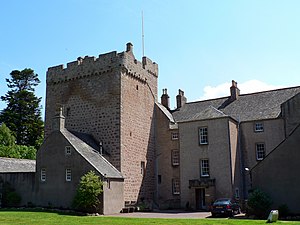
Earl of Elgin is a title in the Peerage of Scotland, created in 1633 for Thomas Bruce, 3rd Lord Kinloss. He was later created Baron Bruce, of Whorlton in the County of York, in the Peerage of England on 30 July 1641. The Earl of Elgin is the hereditary Clan Chief of Clan Bruce.

Baron Macdonald, of Slate in the County of Antrim, is a title in the Peerage of Ireland. It was created in 1776 for Sir Alexander Macdonald, 9th Baronet, of Sleat. The Macdonald family of Sleat descends from Uisdean Macdonald, also known as Hugh of Sleat, or Hugh Macdonald, who was an illegitimate son of Alexander Macdonald, Earl of Ross. On 28 May 1625, his great-great-great-great-grandson Donald Gorm Og Macdonald was created a baronet, of Sleat in the Isle of Skye in the County of Inverness, in the Baronetage of Nova Scotia. The baronetcy was created with remainder to heirs male whatsoever and with a special clause of precedence which provided that it should have precedency over all former baronets.
Sir Charles Hilton Seely, 2nd Baronet, VD, KGStJ was a British industrialist, landowner and Liberal Unionist politician who served as Member of Parliament (MP) for Lincoln from 1895 to 1906 and for Mansfield from 1916 to 1918. He was a Justice of the Peace for Hampshire and Nottinghamshire and the Deputy Lieutenant for Nottinghamshire. He was also a Knight of Grace of the Order of St John.

Clan Rose is a Scottish clan of the Scottish Highlands.
Simon Fraser, 13th Lord Lovat and 2nd Baron Lovat, was a Scottish peer. While legally the 13th Lord, he was referred to as the 15th Lord Lovat.
James Stuart, 4th Earl of Moray was a Scottish landowner.

The Chaytor family is an English gentry family on which has been conferred two baronetcies, one in the Baronetage of England and one in the Baronetage of the United Kingdom and several knighthoods. As of 2008 one baronetcy is extinct.

There have been four baronetcies created for persons with the surname Hope, three in the Baronetage of Nova Scotia and one in the Baronetage of the United Kingdom. As of 2010 one creation is extant, one dormant and two extinct.
There have been five baronetcies created for members of Clan Ramsay, four in the Baronetage of Nova Scotia and one in the Baronetage of the United Kingdom. The baronetcy in the Baronetage of the United Kingdom is extant as of 2022.

Sir Andrew Agnew, 8th Baronet DL was a British politician and baronet.
Walter Campbell, 3rd of Shawfield and Islay and 9th of Skipness was a Scottish landowner, advocate and Rector of Glasgow University.
The title of Lord Ross was a Lordship of Parliament in the Peerage of Scotland. It was created in 1499 for Sir John Ross, of Halkhead.
There have been three baronetcies created for people with the surname Moncreiffe or Moncreiff, two in the Baronetage of Nova Scotia and one in the Baronetage of the United Kingdom. Two of the titles are dormant, as the heir has not proved his descent, and one is extant, though its holder does not bear the surname of Moncreiffe.
The Barony of Muirton is a Scottish feudal barony near Forres along the Findhorn River in Moray.

Hugh Rose, 15th Baron of Kilravock and Chief of Clan Rose, (1663–1732) was one of the Scottish representatives to the first Parliament of Great Britain as MP for Nairnshire.

Hugh Rose, 16th Baron of Kilravock (1684-1755) was a Member of Parliament for Ross-shire and Chief of Clan Rose. The eldest son of Hugh Rose, 15th of Kilravock, he inherited his fathers estates and the Clan Chiefdom on his father's death in 1732.

Hugh Rose, 20th Baron of Kilravock (1781-1827) was a Member of Parliament for Nairnshire and Chief of Clan Rose. The eldest son of Hugh Rose of Brea and Broadley and his wife Elizabeth Rose, Lady of Kilravock, he inherited his mother's estates and the Clan Chiefdom on her death in 1815.

Sir William Rose was a British barrister and civil servant who served as Clerk of the Parliaments from 1875 to 1885, succeeding his father.

Major James Rose, 23rd Baron of Kilravock (1820-1909) was a British Army officer serving in British India, the Lord Lieutenant of Nairn and the Chief of Clan Rose. The third surviving son of Hugh Rose, 20th of Kilravock by his second wife, Catherine Mackintosh of Farr.










